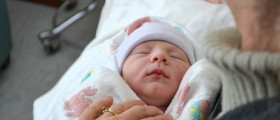A multipara is a woman who has given birth more than once, while a grand multipara has had more than five children. If you are pregnant with again after having more than five children, will an obstetrician/gynecologist automatically deem your pregnancy to be high risk?

The term "grand multipara" was coined during a study in 1934, which concluded that having had more than five children increased the risk of a subsequent pregnancy. According to this study, risks of complications during pregnancy rise steadily between the fifth and tenth pregnancies. Since that study, there has been a lot more research about the links between parity and complications during pregnancy (and birth). Findings have been varied, as has the quality of the research... as in every field.
Even the definitions of grand multiparity vary, with some countries including stillbirths in utero (after 20 weeks pregnancy), while others do not, and only count live births toward the parity figure. In addition, those women who have had more than five children, and especially more than ten children, are very likely to be older mothers, hence increasing the risk of their pregnancy regardless of how many pregnancies they previously experienced. Some also point to the possibility that women from lower socio-economic backgrounds are more likely to have more children. Factors like poor nutrition, prenatal care, and long working hours could play a role in increasing the risk of a particular pregnancy as well.
From an obstetrical viewpoint, a woman who is a grand multipara will almost certainly receive the "high risk" label during her pregnancy. Doctors may be more likely to push for prenatal screening and diagnostic tests, and request more frequent prenatal appointments and more rigorous monitoring during labor and birth.
While it's very likely that being a grand multipara does place women at an increased risk of pregnancy complications, some of these can be decreased by being healthy when one goes into a pregnancy, and eating an excellent diet, exercising regularly, and receiving good prenatal care during a pregnancy.
- www.who.int/bulletin/archives/77(2)190.pdf
- Photo courtesy of SupportPDX by Flickr: www.flickr.com/photos/rocketboom/33775575444/

















Your thoughts on this
Loading...